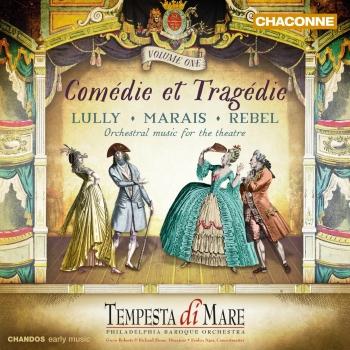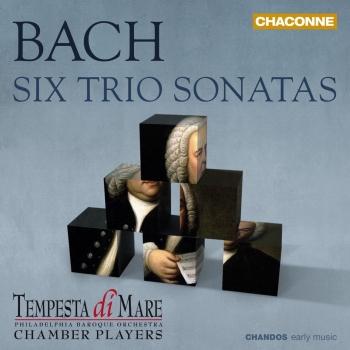
Bach: Six Trio Sonatas Re-Imagined for Chamber Orchestra Tempesta di Mare
Album Info
Album Veröffentlichung:
2014
HRA-Veröffentlichung:
05.09.2022
Label: Chandos
Genre: Classical
Subgenre: Orchestral
Interpret: Tempesta di Mare
Komponist: Johann Sebastian Bach (1685-1750)
Das Album enthält Albumcover Booklet (PDF)
- Johann Sebastian Bach (1685 - 1750): Trio Sonata No. 1 in B-Flat Major, BWV 525 (Arr. for Chamber Ensemble):
- 1 Bach: Trio Sonata No. 1 in B-Flat Major, BWV 525 (Arr. for Chamber Ensemble): I. Allegro 02:40
- 2 Bach: Trio Sonata No. 1 in B-Flat Major, BWV 525 (Arr. for Chamber Ensemble): II. Adagio 06:23
- 3 Bach: Trio Sonata No. 1 in B-Flat Major, BWV 525 (Arr. for Chamber Ensemble): III. Allegro 03:36
- Trio Sonata No. 2 in D Minor, BWV 526 (Arr. for Chamber Ensemble):
- 4 Bach: Trio Sonata No. 2 in D Minor, BWV 526 (Arr. for Chamber Ensemble): I. Vivace 03:43
- 5 Bach: Trio Sonata No. 2 in D Minor, BWV 526 (Arr. for Chamber Ensemble): II. Largo 02:47
- 6 Bach: Trio Sonata No. 2 in D Minor, BWV 526 (Arr. for Chamber Ensemble): III. Allegro 03:56
- Trio Sonata No. 3 in E Minor, BWV 527 (Arr. for Chamber Ensemble):
- 7 Bach: Trio Sonata No. 3 in E Minor, BWV 527 (Arr. for Chamber Ensemble): I. Andante 05:12
- 8 Bach: Trio Sonata No. 3 in E Minor, BWV 527 (Arr. for Chamber Ensemble): II. Adagio e dolce 05:16
- 9 Bach: Trio Sonata No. 3 in E Minor, BWV 527 (Arr. for Chamber Ensemble): III. Vivace 04:22
- Trio Sonata No. 4 in D Minor, BWV 538 (Arr. for Chamber Ensemble):
- 10 Bach: Trio Sonata No. 4 in D Minor, BWV 538 (Arr. for Chamber Ensemble): I. Adagio - Vivace 02:39
- 11 Bach: Trio Sonata No. 4 in D Minor, BWV 538 (Arr. for Chamber Ensemble): II. Andante 04:05
- 12 Bach: Trio Sonata No. 4 in D Minor, BWV 538 (Arr. for Chamber Ensemble): III. Un poc' allegro 02:43
- Trio Sonata No. 5 in F Major, BWV 529 (Arr. for Chamber Ensemble):
- 13 Bach: Trio Sonata No. 5 in F Major, BWV 529 (Arr. for Chamber Ensemble): I. Allegro 04:17
- 14 Bach: Trio Sonata No. 5 in F Major, BWV 529 (Arr. for Chamber Ensemble): II. Largo 04:14
- 15 Bach: Trio Sonata No. 5 in F Major, BWV 529 (Arr. for Chamber Ensemble): III. Allegro 03:16
- Trio Sonata No. 6 in G Major, BWV 530 (Arr. for Chamber Ensemble):
- 16 Bach: Trio Sonata No. 6 in G Major, BWV 530 (Arr. for Chamber Ensemble): I. Vivace 03:34
- 17 Bach: Trio Sonata No. 6 in G Major, BWV 530 (Arr. for Chamber Ensemble): II. Lente 06:38
- 18 Bach: Trio Sonata No. 6 in G Major, BWV 530 (Arr. for Chamber Ensemble): III. Allegro 03:17
Info zu Bach: Six Trio Sonatas Re-Imagined for Chamber Orchestra
Bach compiled his set of six trio sonatas for organ during the late 1720s. They are thought to have been put together as training material for Bach’s son Wilhelm Friedemann and can be grouped among other pedagogical keyboard collections such as the Inventions and the Well-Tempered Clavier. They are unique, however, in transferring the typical trio sonata texture, a popular style normally played by ensemble, to a single instrument. In Bach’s originals the right and left hands take the top two parts while the pedals perform the bass line. The first movement of Sonata No. 4 was originally composed for ensemble and the unique formal and stylistic characteristics of the collection suggest that other movements, too, started life away from the organ.
Taking this on board, Tempesta di Mare Chamber Players have re-imagined these works in arrangements for ensemble, using scorings typically adopted in the performance of trio sonatas in Bach’s time. Bach was himself a serial adapter and re-arranger of his own works and this recording takes on his understanding of the musical work as a fluid entity, able to assume as many forms as there are purposes for them.
The Philadelphia-based early music ensemble Tempesta di Mare is renowned for its unique programming and championing of rarely performed works, not least through its fruitful relationship with Chandos Records.
"...The performances are highly sympathetic it’s an enjoyable and instructive set the slow movement of No 4 being worth the price of admission on its own." (Fabrice Fitch, Gramophone magazine)
“… At times organist will barely recognize this music, but there’s no harm in that. Music of such supreme genius can withstand being looked at from a wholly new perspective, and when played with such conviction as here, questions of authenticity seem wholly irrelevant.” (Marc Rochester, International Record Review)
Tempesta di Mare Philadelphia Baroque Orchestra
Tempesta di Mare
performs baroque music on baroque instruments with what the Philadelphia City Paper describes as “zest and virtuosity that transcends style and instrumentation.” Led by co-directors Gwyn Roberts and Richard Stone with concertmaster Emlyn Ngai, Tempesta di Mare's repertoire ranges from staged opera with full orchestra to chamber music.
Tempesta di Mare is named for baroque master Antonio Vivaldi’s concerto meaning “storm at sea,” a title reflecting composers’ belief in the power of their music to evoke drama. Roberts and Stone founded Tempesta in 1996 to pursue their ideal of baroque music as a rhetorical, dramatic art form. The group’s debut CD of recorder sonatas by Veracini, released that year on PGM, received BBC Music Magazine's highest rating, with such praise as “world-class virtuosity” and “breathtaking results.”
Hailed by the Philadelphia Inquirer for its “off-the-grid chic factor,” Tempesta’s Greater Philadelphia Concert Series has enjoyed a rapid rise to prominence since its launch in 2002, with press endorsements from Philadelphia to Paris. With an emphasis on breaking new ground, Tempesta di Mare has brought numerous world, national and regional modern premieres to the area. Tempesta di Mare—the only permanent baroque ensemble in Pennsylvania that consistently performs orchestral repertoire with truly orchestral forces—is one of just three baroque orchestras nationwide to receive the National Endowment for the Arts Artistic Excellence Award in 2007, and again with two more Artistic Excellence awards for 2008.
Tempesta di Mare’s CD Flaming Rose, Handel's German Arias with soprano Julianne Baird, was released in August 2007 on the British label Chandos, the world's largest independent classical record company. In a market dominated by European ensembles, Tempesta di Mare is the first and only American baroque music group on the Chandos roster. Its first Chandos release, the world premiere recording of the complete lute concerti of Silvius Leopold Weiss, was released in June 2004. A third Chandos disc, modern premieres of orchestral music by Johann Friedrich Fasch, recorded live in concert on our Greater Philadelphia Concert Series in 2007, was released in April 2008.
Tempesta has toured from Oregon to Prague, with praise ranging from “the energy of a rock solo and the craft of a classical cadenza” (Washington Post) to “an experience of intimate dialogues” (Lidové Noviny, Prague). National broadcasts of performances include Performance Today, Sunday Baroque and Harmonia. Concerts are carried locally on WHYY-91FM's Showcase and video of recent performances can be seen on WYBE Public Television. WHYY TV12 has also produced three short documentaries about the group.
Booklet für Bach: Six Trio Sonatas Re-Imagined for Chamber Orchestra











